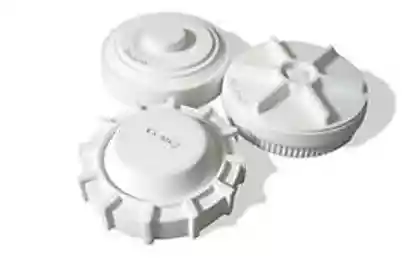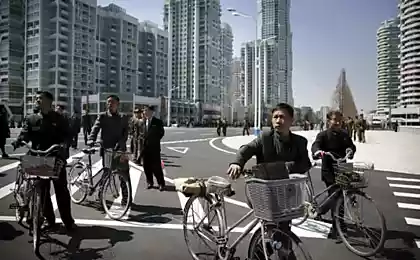414
Marketing and Reality of the Spring Mono Wheel 2017
It is no secret that manufacturers and sellers can embellish the characteristics of their products to make them look better compared to competitors. Often you do not even need to deceive directly - you can keep silent about the exact definition and degree of importance of a characteristic or bring it for certain conditions, and ignorant buyers will easily be deceived themselves. On the territory of Russia is already in full spring, the season of riding on summer gadgets is approaching, and in this publication I would like to help those who are interested in the topic of monowheels and do not know what characteristics they are better to choose.

The classic of marketing is the girl and the product. The original source is unknown - shops copy this photo from each other.
Required disclaimerI am not affiliated with any manufacturer or seller of monowheels, do not advertise any of the models, manufacturers or sellers mentioned below, and express exclusively my opinion based on my own experience and information from profile forums and sites. As an enthusiast of monowheels as a mode of transport, I want their number of owners to increase, and the operating experience to be as positive as possible.
Maximum speedOne of the most obvious and important parameters - maximum speed - contains several pitfalls for an inexperienced buyer. First of all, the maximum speed of one monowheel is at least three. The first is the maximum safe speed. When it is exceeded, the wheel begins to emit sound signals and tilt the pedals horizon so that the sock is above the heel (in established terminology, “lift the pedal”). Sound and tactile signals tell the user that further acceleration is dangerous. But because of the physics of maintaining equilibrium, the wheel cannot be forced to brake, because then it will immediately drop the rider. Therefore, the wheel can be overstimulated and accelerated further, without paying attention to warnings. Then, at some sudden and unpleasant moment, the rate of loss of balance will come. On it, the wheel will not have enough power to constantly drive under the rider, and it will drop it. The exact moment of balance loss cannot be predicted in advance - it is caused by random bumps, accelerations or other loads. And finally, if you lift the monowheel into the air and tilt it, it will begin to accelerate without load. At some point, the control system will stop accelerating, give an audible signal and stop the wheel. This speed is called the cutoff speed.
In practice, the maximum safe speed ranges from 12 km/h for very weak wheels to 35-40 km/h. This speed also depends on the battery charge. When the battery is discharged, it cannot deliver full power, and the control system reduces the maximum safe speed, for example, by half. In addition, sometimes this speed is programmatically limited on the first kilometers of the wheel, or its maximum possible value must be separately unlocked. And finally, it can usually be manually limited in a smartphone app that connects to the wheel.
The rate of loss of balance in practice is checked by individual dareheads, accelerating until the wheel drops them. For wheels with powerful motors and large batteries, speeds around 50 km / h were achieved, but this is very unhealthy, inaccurate, and in reality this speed is not indicated in the characteristics of the wheel.
And finally, the cutoff speed, which reached the vicinity of 60 km / h, is sometimes indicated by manufacturers. But it makes no practical sense.
Conclusion: Most sellers are adequate and in the characteristics of the wheels indicate the maximum safe speed. These numbers are usually true. Only very old or weak wheels (usually nouneim) will not be able to accelerate to the stated speed. But if you see a top speed in the region of 60 km / h, then they try to misinform you, showing a characteristic detached from real driving.
Power reserve.Another very important parameter is how much you can travel on one battery charge. And here some of the information is formally correct, but only for specific conditions, and some features are not explicitly mentioned. In the characteristics of stores and manufacturers, the power reserve is often indicated more than the battery capacity in watt hours divided by 10. That is, for a wheel with a battery of 170 Wh can write a power reserve of 20 or even 25 km. Such mileage is physically possible, but only for a light rider up to 60 kg of weight and a slow ride on a smooth good road in warm weather. Heavy rider, fast driving in the urban cycle with frequent stops and accelerations, ascents and descents, cool weather – all these factors will reduce maximum mileage. In reality, it is more correct to use the coefficient in the region of 0.07, i.e. on a wheel with a battery of 680 Wh you can drive about 48 km. Also, the control system of the monowheel reduces the maximum safe speed when the battery is discharged to about a third (in different models in different ways). This is a logical and correct concern for our safety, because a discharged battery will not be able to give full power, but the comfort of driving on the last kilometers is lost. And finally, over time, the batteries will lose capacity, and the power reserve will decrease even more. Personally, I had no practical experience and did not trust the “Chinese watts”, divided the battery capacity by 20. That’s a very conservative estimate, but even in cold weather, I still had a third of the 680Wh battery left after commuting to and from work at ~30km.
Bottom Line: Store range figures are everywhere listed for light Chinese who will ride on the tropical island of Hainan. When choosing the right battery for you, it is better to use the coefficient of 0.07* battery capacity in Wh and round in the lower direction. If you want maximum accuracy, you can use an online calculator. There you can also assess the impact of various factors on the power reserve.
PowerWhat is the power of the monowheel engine? Mainly on safety and ease of driving. A powerful wheel will not drop a rider on a random bump, can sharply accelerate and brake, without problems it will run on a steep climb or even on the ramp of an underground passage. In addition, a powerful wheel can accelerate to a higher speed, but here you need to know the measure, so as not to reduce the safety of driving - fall from twice the speed four times more painful, because the kinetic energy is proportional to the square of the speed. In the matter of power monowheels until recently, it was possible to freely engage in speculation: on the body of the engine, the manufacturer could write any power, and there were no good methods for measuring the power of the wheel. Without special stands and devices, it was possible to assess the power of the wheel on the eye, trying to “push” it – tilt the standing wheel so that the engine tried to disperse it. Bad wheels from such a test burned, weak - bent and turned off. But modern wheels have reached such power that they often could not be pushed. The situation was further confused by the fact that the power in this case is at least two types – maximum (established mode) and peak (very short-term load). A more serious test was needed. And of all the invented options for today, the best methodological approach was the Russian company - the seller of monowheels EcoDrift - they began to rent a dynamometer stand for motorcycles. This solution found shortcomings, the main of which was too heavy drum load. On the test wheels began to burn fuses. But, at least, many different monowheels were in the same test conditions with the possibility of recording numerical parameters.
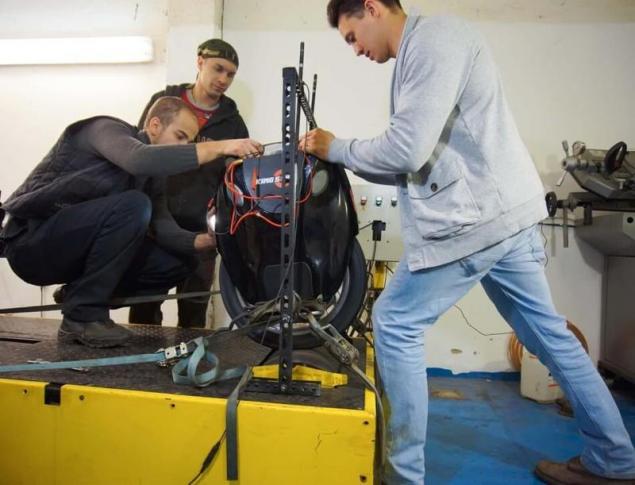
The process of testing the monowheel on the dynostand. The wheel is tilted so that it spins the drum. Hanging wires are an additional logger.
In the segment of cheap wheels, the situation was sad, but, alas, quite expected. The cheapest of all found wheels, bought on Avito, burned at a speed of only 2 km / h. The monocole of the unknown company EYU with a battery of 174 Wh was able to produce only 500 watts of power, which can create problems even when riding a child on it. And the cheapest model of the famous and respected company Kingsong, KS-14B with a battery of 174 Wh, showed 1.1 kW of power. It seems that this model is minimally adequate for an adult, everything that is cheaper is unlikely to please the buyer.
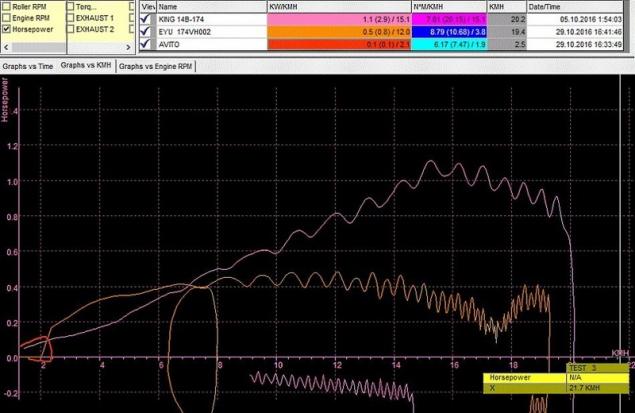
The next group brought monowheels with a diameter of 14 inches with batteries ~340 Wh. This segment is very popular, because ~24 km of mileage (with a coefficient of 0.07 above) per battery charge is enough for a lot of people, and the price here is still low. There is no Kingsong KS-14C 340 Wh on the graph, the result is similar to Gotway MCM4. With the exception of the IPS Zero wheels, the performance will not be the deciding factor.
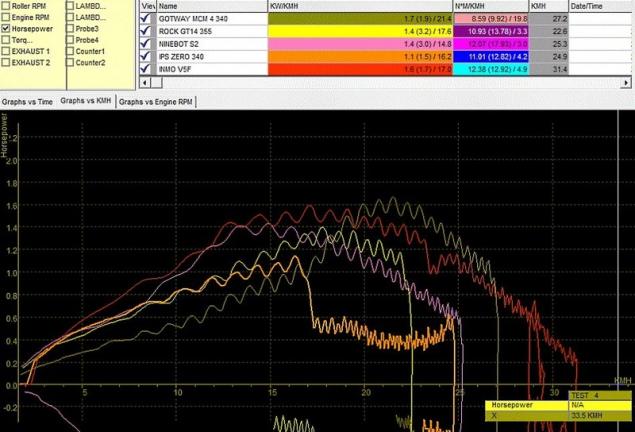
The KS-14C has another variant with a 680 Wh battery, the additional battery capacity allowed to show a slightly higher power of 1.9 kW.
Another group is a monowheel with a diameter of 16 inches. If you discard the nouneim and outdated models, then there will be Kingsong KS-16 with batteries of different capacities (on the chart options with 340 Wh and 840 Wh), the novelty of the autumn 2016 Inmotion V8 and Gotway ACM. The graphs on the stand turned out to be remarkably similar, and no model has a critical advantage in power.
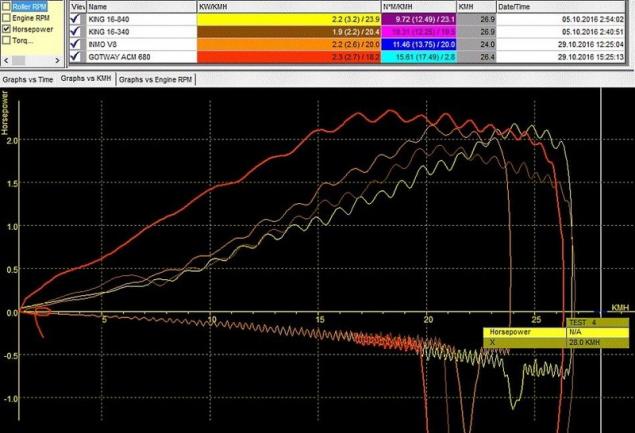
Well, the last segment is a monowheel with a diameter of 18 inches. Only two candidates are the Kingsong KS-18 and Gotway MSuper V3. In terms of power, the unambiguous winner is the modification of the MSuper V3+ with a huge battery of 1600 Wh and increased to 84 volts working voltage. But nothing comes for nothing - this model is one of the most expensive and heavy.
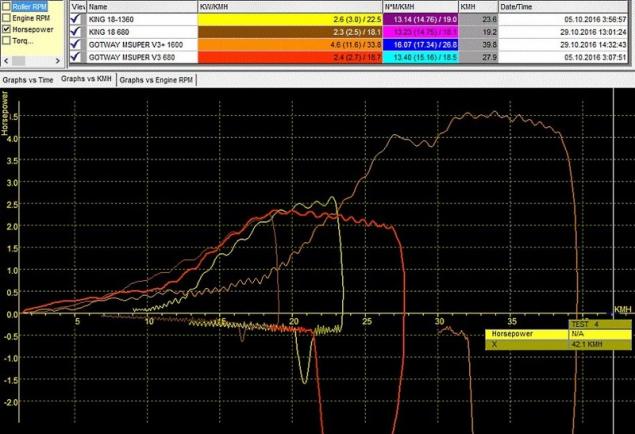
Interestingly, factory models of monowheels do not realize their full potential, because manufacturers do not put the most powerful (but cheaper) batteries. On lithium-iron-phosphate batteries, the power of the same monowheel (both Gotway ACM) has increased markedly.
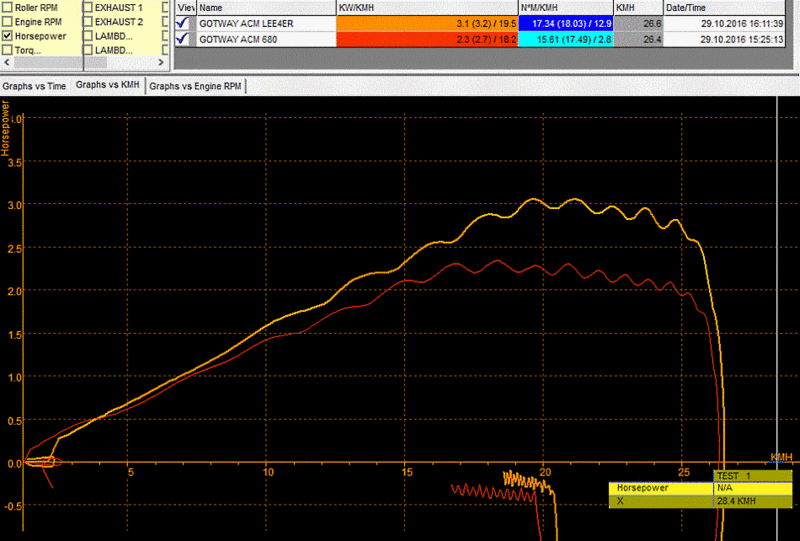
And finally, the test stand dispelled the myths that were whipped up around the Solowheel wheels. It was with them that the history of modern monowheels began in 2011, but now, six years later, Chinese manufacturers have overtaken them. On the forums for a long time, disputes over the alleged huge power of the 18-inch Extreme model did not cease, but bench tests put a bold point on these conversations - with a battery of less than 200 Wh, a miracle did not happen, and the Solowheel Extreme showed only 1.3 kW of power. Another model, the Kingsong KS-14D, came out after the 14-inch wheel graph was published, and its results added here.
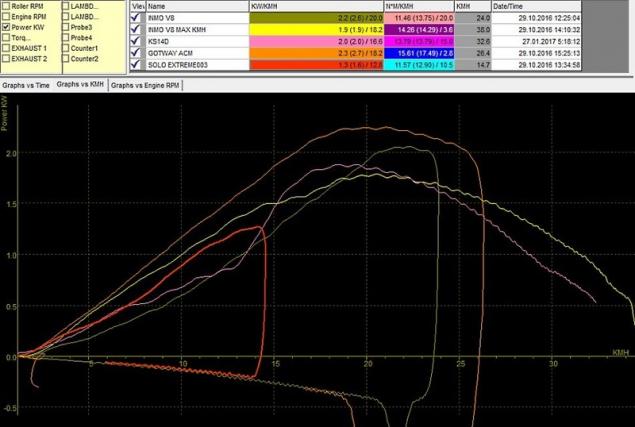
Conclusion: The cheapest models can’t be powerful, and among market leaders, power is usually not the most important factor.
A small educational program for manufacturersThere are two factors in the monowheel market. On the one hand, the concept of the ideal monowheel has not yet been established, new ideas and technical solutions appear. On the other hand, the business is still not very profitable, firms can switch to other devices or go bankrupt. As a result, models of 2015 and older are already morally outdated, and unscrupulous sellers can sell illiquid stocks, presenting them as modern models. In the spring of 2017, the leaders of the monowheel market are three companies - Gotway, Inmotion, Kingsong. Other manufacturers lag behind the “big three”. Airwheel is stuck in the design of Solowheel replicas (which almost all Chinese manufacturers started with). Russian distributors in the spring of 2016 generously for advertising Varlamov, but even then there were many models with noticeably better characteristics. At the end of 2015, Firewheel began to plummet in quality, and now the manufacturer is virtually forgotten. IPS, as it turned out, overstated the power of its engines, and has not released new models for a long time. They say that something new is being prepared, but there is no more specific information.
Ninebot made a trendsetter and the most beautiful monowheel of 2015, but then switched to Segways and mini-Segways. It turned out a funny chain – the creator of the original Segway, the company Segway was bought by Ninebot, and a major investor of Ninebot in turn is Xiaomi. Ninebot seems to be doing well, but the monowheels no longer seem to interest her. Rockwheel once made interesting models, but is now on the verge of bankruptcy. At the beginning of 2017, they released a new wheel, but there are a lot of complaints about design, construction, safety and reliability, and I will definitely not recommend it to beginners.
Market leaders have the following models:
gotway

From left to right: Luffy, MCM4, ACM, MSuper V3, Monster
Today, the company has the largest choice of monowheel diameters. The 10’ Luffy, which has just appeared, is testing the demand for the segment of very compact monowheels. The 14’ MCM4 looks outdated without a built-in retractable handle and headlight, but you can drive it. The 16'' ACM features an angular design and, again, the lack of a built-in retractable handle (don't think I'm picky, such handles are very comfortable, and screwed-up ones spoil the view). The 18′′ MSuper V3 appeared in the fall of 2016 and is probably the best monowheel with an 18 inch diameter. But for speed, power and power reserve have to pay in size, weight and price. Finally, the 22 Monster is testing how big a monowheel can be without losing its practicality.
Inmotion
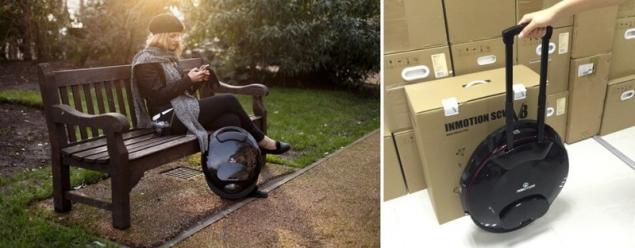
From left to right: V5, V8
Inmotion, on the contrary, makes monowheels in just two diameters, but thanks to the very cute design and good characteristics, they are popular. A feature of this company are the buttons to turn off the wheel under the handle, so that it does not unwind on weight. The 14′′ V5 with modifications (V5+, V5F, V5F+), probably the most important drawback is the lack of versions with large batteries. And the 16′′ V8, which appeared in the fall, turned out to be very light, cute, but the replaceable battery, in my opinion, is not a particularly useful idea, and there are no versions with large batteries.
Kingsong
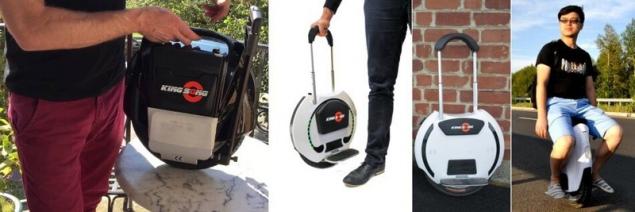
From left to right: KS-14C, KS-16A, KS-14D, KS-18
Kingsong has a rather original design and the mandatory presence of speakers in a monowheel. Not to say that this is a very important feature, but there is no need to purchase a separate Bluetooth speaker, and riding in a quiet park to atmospheric music can be very pleasant. 14'' KS-14B and C are probably the most budget wheels, there is a version with a large battery of 680 Wh, except that the retractable handle will have to "kolkhoz" yourself. In the 16′′ model KS-16A was implemented, in my opinion, the most ergonomic design – one diagonal retractable handle passes through the center of gravity, and behind it you can both lift and roll the wheel (the MSuper V3 and V8 have two handles). The same decision was repeated in the new model KS-14D, which appeared in Russia in early 2017. And, finally, the 18′′ KS-18 is so high that the set comes with a seat, and you can go not only standing, but also sitting.
Choosing a monowheelThe most rational way to decide on the choice of a monowheel is to write out your wishes and limitations, and on their basis to look for suitable options. How much money are you willing to spend as much as possible? What mileage will you have between charges (usually one day if you are not ready to charge the wheel, for example, at work)? Is there a particular feature you like, need or don’t want (someone might hate LED ribbons on the sides or love music)? The choice is quite wide, you can find what you like the most. It is also useful to look for uni-wheelers in your city (and in large cities they are already there) - they can share their experience, assess the course of your reasoning, show their wheels and greatly accelerate learning to ride.
ConclusionA monocoleso is a very compact form of transport that fits in any bus, can go on average faster than a bicycle, does not need bicycle parking (so it will not be stolen from there), requires minimal maintenance, spends three cents of electricity for one kilometer and is controlled by the position of the body so that it feels like you are hovering above the ground with the power of thought. The combination of such characteristics, in my opinion, is an unequivocal application for the monowheel to become the transport of the future.
P.S. And remember, just changing our consumption – together we change the world!
Source: geektimes.ru/post/286854/

The classic of marketing is the girl and the product. The original source is unknown - shops copy this photo from each other.
Required disclaimerI am not affiliated with any manufacturer or seller of monowheels, do not advertise any of the models, manufacturers or sellers mentioned below, and express exclusively my opinion based on my own experience and information from profile forums and sites. As an enthusiast of monowheels as a mode of transport, I want their number of owners to increase, and the operating experience to be as positive as possible.
Maximum speedOne of the most obvious and important parameters - maximum speed - contains several pitfalls for an inexperienced buyer. First of all, the maximum speed of one monowheel is at least three. The first is the maximum safe speed. When it is exceeded, the wheel begins to emit sound signals and tilt the pedals horizon so that the sock is above the heel (in established terminology, “lift the pedal”). Sound and tactile signals tell the user that further acceleration is dangerous. But because of the physics of maintaining equilibrium, the wheel cannot be forced to brake, because then it will immediately drop the rider. Therefore, the wheel can be overstimulated and accelerated further, without paying attention to warnings. Then, at some sudden and unpleasant moment, the rate of loss of balance will come. On it, the wheel will not have enough power to constantly drive under the rider, and it will drop it. The exact moment of balance loss cannot be predicted in advance - it is caused by random bumps, accelerations or other loads. And finally, if you lift the monowheel into the air and tilt it, it will begin to accelerate without load. At some point, the control system will stop accelerating, give an audible signal and stop the wheel. This speed is called the cutoff speed.
In practice, the maximum safe speed ranges from 12 km/h for very weak wheels to 35-40 km/h. This speed also depends on the battery charge. When the battery is discharged, it cannot deliver full power, and the control system reduces the maximum safe speed, for example, by half. In addition, sometimes this speed is programmatically limited on the first kilometers of the wheel, or its maximum possible value must be separately unlocked. And finally, it can usually be manually limited in a smartphone app that connects to the wheel.
The rate of loss of balance in practice is checked by individual dareheads, accelerating until the wheel drops them. For wheels with powerful motors and large batteries, speeds around 50 km / h were achieved, but this is very unhealthy, inaccurate, and in reality this speed is not indicated in the characteristics of the wheel.
And finally, the cutoff speed, which reached the vicinity of 60 km / h, is sometimes indicated by manufacturers. But it makes no practical sense.
Conclusion: Most sellers are adequate and in the characteristics of the wheels indicate the maximum safe speed. These numbers are usually true. Only very old or weak wheels (usually nouneim) will not be able to accelerate to the stated speed. But if you see a top speed in the region of 60 km / h, then they try to misinform you, showing a characteristic detached from real driving.
Power reserve.Another very important parameter is how much you can travel on one battery charge. And here some of the information is formally correct, but only for specific conditions, and some features are not explicitly mentioned. In the characteristics of stores and manufacturers, the power reserve is often indicated more than the battery capacity in watt hours divided by 10. That is, for a wheel with a battery of 170 Wh can write a power reserve of 20 or even 25 km. Such mileage is physically possible, but only for a light rider up to 60 kg of weight and a slow ride on a smooth good road in warm weather. Heavy rider, fast driving in the urban cycle with frequent stops and accelerations, ascents and descents, cool weather – all these factors will reduce maximum mileage. In reality, it is more correct to use the coefficient in the region of 0.07, i.e. on a wheel with a battery of 680 Wh you can drive about 48 km. Also, the control system of the monowheel reduces the maximum safe speed when the battery is discharged to about a third (in different models in different ways). This is a logical and correct concern for our safety, because a discharged battery will not be able to give full power, but the comfort of driving on the last kilometers is lost. And finally, over time, the batteries will lose capacity, and the power reserve will decrease even more. Personally, I had no practical experience and did not trust the “Chinese watts”, divided the battery capacity by 20. That’s a very conservative estimate, but even in cold weather, I still had a third of the 680Wh battery left after commuting to and from work at ~30km.
Bottom Line: Store range figures are everywhere listed for light Chinese who will ride on the tropical island of Hainan. When choosing the right battery for you, it is better to use the coefficient of 0.07* battery capacity in Wh and round in the lower direction. If you want maximum accuracy, you can use an online calculator. There you can also assess the impact of various factors on the power reserve.
PowerWhat is the power of the monowheel engine? Mainly on safety and ease of driving. A powerful wheel will not drop a rider on a random bump, can sharply accelerate and brake, without problems it will run on a steep climb or even on the ramp of an underground passage. In addition, a powerful wheel can accelerate to a higher speed, but here you need to know the measure, so as not to reduce the safety of driving - fall from twice the speed four times more painful, because the kinetic energy is proportional to the square of the speed. In the matter of power monowheels until recently, it was possible to freely engage in speculation: on the body of the engine, the manufacturer could write any power, and there were no good methods for measuring the power of the wheel. Without special stands and devices, it was possible to assess the power of the wheel on the eye, trying to “push” it – tilt the standing wheel so that the engine tried to disperse it. Bad wheels from such a test burned, weak - bent and turned off. But modern wheels have reached such power that they often could not be pushed. The situation was further confused by the fact that the power in this case is at least two types – maximum (established mode) and peak (very short-term load). A more serious test was needed. And of all the invented options for today, the best methodological approach was the Russian company - the seller of monowheels EcoDrift - they began to rent a dynamometer stand for motorcycles. This solution found shortcomings, the main of which was too heavy drum load. On the test wheels began to burn fuses. But, at least, many different monowheels were in the same test conditions with the possibility of recording numerical parameters.

The process of testing the monowheel on the dynostand. The wheel is tilted so that it spins the drum. Hanging wires are an additional logger.
In the segment of cheap wheels, the situation was sad, but, alas, quite expected. The cheapest of all found wheels, bought on Avito, burned at a speed of only 2 km / h. The monocole of the unknown company EYU with a battery of 174 Wh was able to produce only 500 watts of power, which can create problems even when riding a child on it. And the cheapest model of the famous and respected company Kingsong, KS-14B with a battery of 174 Wh, showed 1.1 kW of power. It seems that this model is minimally adequate for an adult, everything that is cheaper is unlikely to please the buyer.

The next group brought monowheels with a diameter of 14 inches with batteries ~340 Wh. This segment is very popular, because ~24 km of mileage (with a coefficient of 0.07 above) per battery charge is enough for a lot of people, and the price here is still low. There is no Kingsong KS-14C 340 Wh on the graph, the result is similar to Gotway MCM4. With the exception of the IPS Zero wheels, the performance will not be the deciding factor.

The KS-14C has another variant with a 680 Wh battery, the additional battery capacity allowed to show a slightly higher power of 1.9 kW.
Another group is a monowheel with a diameter of 16 inches. If you discard the nouneim and outdated models, then there will be Kingsong KS-16 with batteries of different capacities (on the chart options with 340 Wh and 840 Wh), the novelty of the autumn 2016 Inmotion V8 and Gotway ACM. The graphs on the stand turned out to be remarkably similar, and no model has a critical advantage in power.

Well, the last segment is a monowheel with a diameter of 18 inches. Only two candidates are the Kingsong KS-18 and Gotway MSuper V3. In terms of power, the unambiguous winner is the modification of the MSuper V3+ with a huge battery of 1600 Wh and increased to 84 volts working voltage. But nothing comes for nothing - this model is one of the most expensive and heavy.

Interestingly, factory models of monowheels do not realize their full potential, because manufacturers do not put the most powerful (but cheaper) batteries. On lithium-iron-phosphate batteries, the power of the same monowheel (both Gotway ACM) has increased markedly.

And finally, the test stand dispelled the myths that were whipped up around the Solowheel wheels. It was with them that the history of modern monowheels began in 2011, but now, six years later, Chinese manufacturers have overtaken them. On the forums for a long time, disputes over the alleged huge power of the 18-inch Extreme model did not cease, but bench tests put a bold point on these conversations - with a battery of less than 200 Wh, a miracle did not happen, and the Solowheel Extreme showed only 1.3 kW of power. Another model, the Kingsong KS-14D, came out after the 14-inch wheel graph was published, and its results added here.

Conclusion: The cheapest models can’t be powerful, and among market leaders, power is usually not the most important factor.
A small educational program for manufacturersThere are two factors in the monowheel market. On the one hand, the concept of the ideal monowheel has not yet been established, new ideas and technical solutions appear. On the other hand, the business is still not very profitable, firms can switch to other devices or go bankrupt. As a result, models of 2015 and older are already morally outdated, and unscrupulous sellers can sell illiquid stocks, presenting them as modern models. In the spring of 2017, the leaders of the monowheel market are three companies - Gotway, Inmotion, Kingsong. Other manufacturers lag behind the “big three”. Airwheel is stuck in the design of Solowheel replicas (which almost all Chinese manufacturers started with). Russian distributors in the spring of 2016 generously for advertising Varlamov, but even then there were many models with noticeably better characteristics. At the end of 2015, Firewheel began to plummet in quality, and now the manufacturer is virtually forgotten. IPS, as it turned out, overstated the power of its engines, and has not released new models for a long time. They say that something new is being prepared, but there is no more specific information.
Ninebot made a trendsetter and the most beautiful monowheel of 2015, but then switched to Segways and mini-Segways. It turned out a funny chain – the creator of the original Segway, the company Segway was bought by Ninebot, and a major investor of Ninebot in turn is Xiaomi. Ninebot seems to be doing well, but the monowheels no longer seem to interest her. Rockwheel once made interesting models, but is now on the verge of bankruptcy. At the beginning of 2017, they released a new wheel, but there are a lot of complaints about design, construction, safety and reliability, and I will definitely not recommend it to beginners.
Market leaders have the following models:
gotway

From left to right: Luffy, MCM4, ACM, MSuper V3, Monster
Today, the company has the largest choice of monowheel diameters. The 10’ Luffy, which has just appeared, is testing the demand for the segment of very compact monowheels. The 14’ MCM4 looks outdated without a built-in retractable handle and headlight, but you can drive it. The 16'' ACM features an angular design and, again, the lack of a built-in retractable handle (don't think I'm picky, such handles are very comfortable, and screwed-up ones spoil the view). The 18′′ MSuper V3 appeared in the fall of 2016 and is probably the best monowheel with an 18 inch diameter. But for speed, power and power reserve have to pay in size, weight and price. Finally, the 22 Monster is testing how big a monowheel can be without losing its practicality.
Inmotion

From left to right: V5, V8
Inmotion, on the contrary, makes monowheels in just two diameters, but thanks to the very cute design and good characteristics, they are popular. A feature of this company are the buttons to turn off the wheel under the handle, so that it does not unwind on weight. The 14′′ V5 with modifications (V5+, V5F, V5F+), probably the most important drawback is the lack of versions with large batteries. And the 16′′ V8, which appeared in the fall, turned out to be very light, cute, but the replaceable battery, in my opinion, is not a particularly useful idea, and there are no versions with large batteries.
Kingsong

From left to right: KS-14C, KS-16A, KS-14D, KS-18
Kingsong has a rather original design and the mandatory presence of speakers in a monowheel. Not to say that this is a very important feature, but there is no need to purchase a separate Bluetooth speaker, and riding in a quiet park to atmospheric music can be very pleasant. 14'' KS-14B and C are probably the most budget wheels, there is a version with a large battery of 680 Wh, except that the retractable handle will have to "kolkhoz" yourself. In the 16′′ model KS-16A was implemented, in my opinion, the most ergonomic design – one diagonal retractable handle passes through the center of gravity, and behind it you can both lift and roll the wheel (the MSuper V3 and V8 have two handles). The same decision was repeated in the new model KS-14D, which appeared in Russia in early 2017. And, finally, the 18′′ KS-18 is so high that the set comes with a seat, and you can go not only standing, but also sitting.
Choosing a monowheelThe most rational way to decide on the choice of a monowheel is to write out your wishes and limitations, and on their basis to look for suitable options. How much money are you willing to spend as much as possible? What mileage will you have between charges (usually one day if you are not ready to charge the wheel, for example, at work)? Is there a particular feature you like, need or don’t want (someone might hate LED ribbons on the sides or love music)? The choice is quite wide, you can find what you like the most. It is also useful to look for uni-wheelers in your city (and in large cities they are already there) - they can share their experience, assess the course of your reasoning, show their wheels and greatly accelerate learning to ride.
ConclusionA monocoleso is a very compact form of transport that fits in any bus, can go on average faster than a bicycle, does not need bicycle parking (so it will not be stolen from there), requires minimal maintenance, spends three cents of electricity for one kilometer and is controlled by the position of the body so that it feels like you are hovering above the ground with the power of thought. The combination of such characteristics, in my opinion, is an unequivocal application for the monowheel to become the transport of the future.
P.S. And remember, just changing our consumption – together we change the world!
Source: geektimes.ru/post/286854/




